Abstract
If neoplastic transformation of diploid human cells results from carcinogen-induced mutations, cells deficient in excision repair of UV-induced DNA damage should be significantly more sensitive to transformation by UV light than normal cells. We tested this hypothesis by irradiating fibroblasts from a xeroderma pigmentosum patient (XP7BE, complementation group D) with low doses of Uv light (254 nm) and cells from a normal person with much higher doses and comparing the frequency of transformation to anchorage independence. Both sets of cells exhibited a dose-dependent increase in transformation which corresponded to a dose-dependent decrease in survival. At doses that caused equal cell killing, the frequency of anchorage-independent cells was approximately equal. Colonies of XP7BE and normal cells isolated from agar, propagated, and injected into X-irradiated athymic mice produced fibrosarcomas in 100% of the animals. Normal cells irradiated shortly before the onset of DNA synthesis exhibited a high frequency of anchorage-independent cells; cells irradiated in early G1 showed no increase over background. These results agree with those we observed for UV induction of 6-thioguanine-resistant mutants in these cells and support the hypothesis that anchorage independence results from mutations induced by DNA replication on a damaged template.
Full text
PDF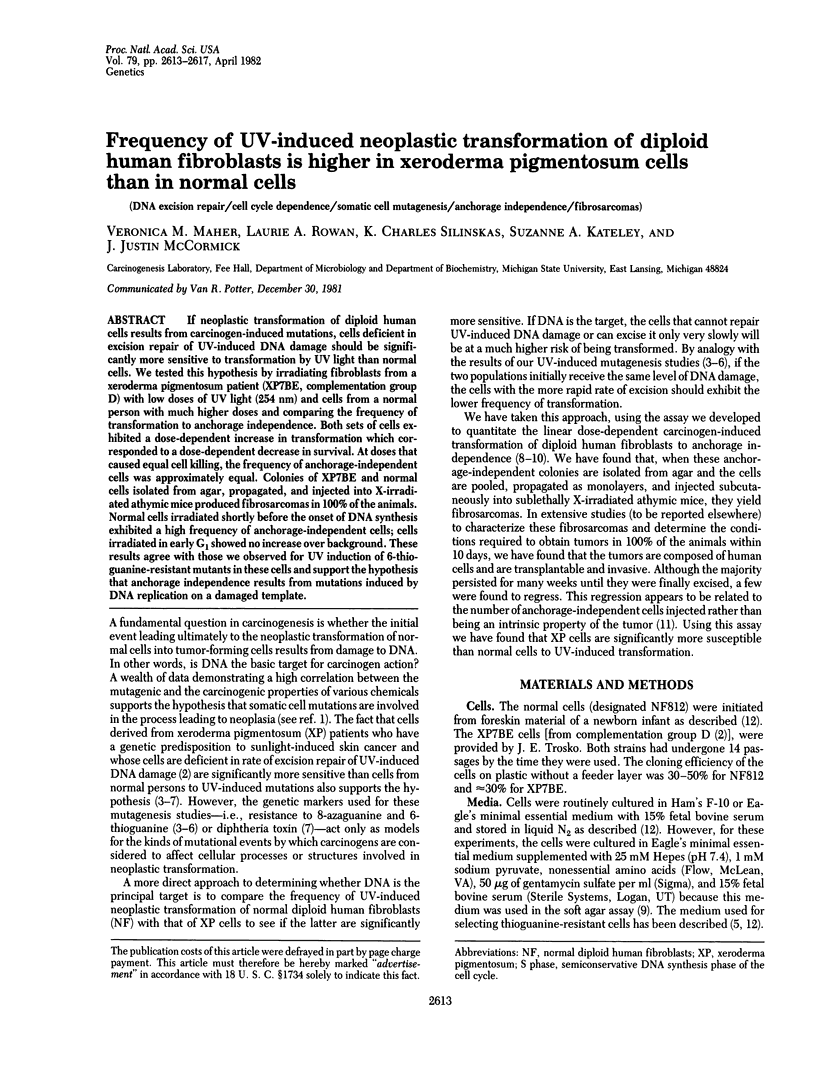
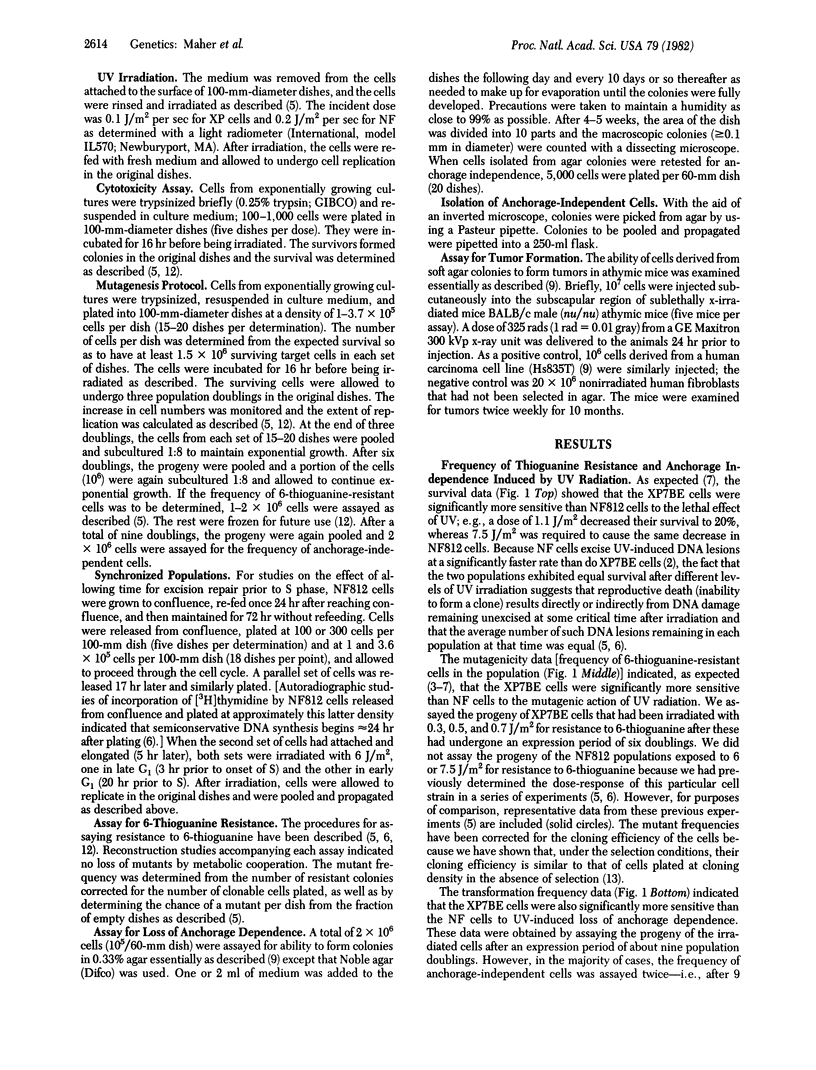
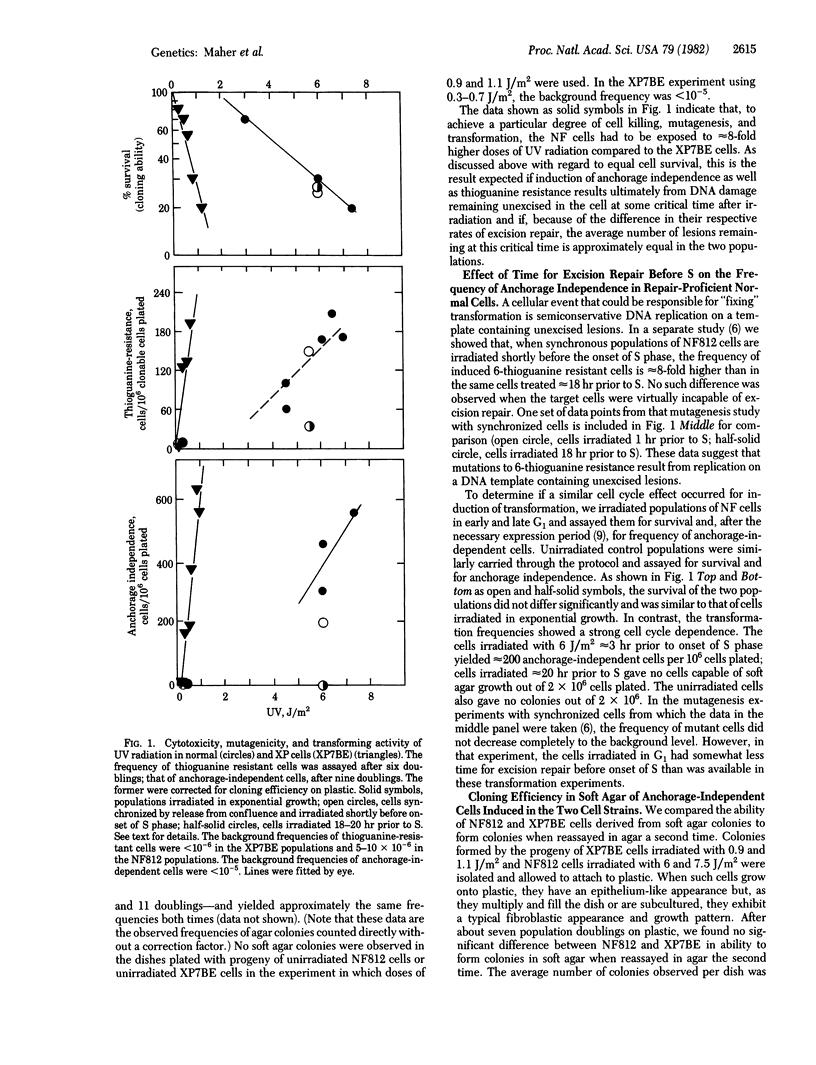
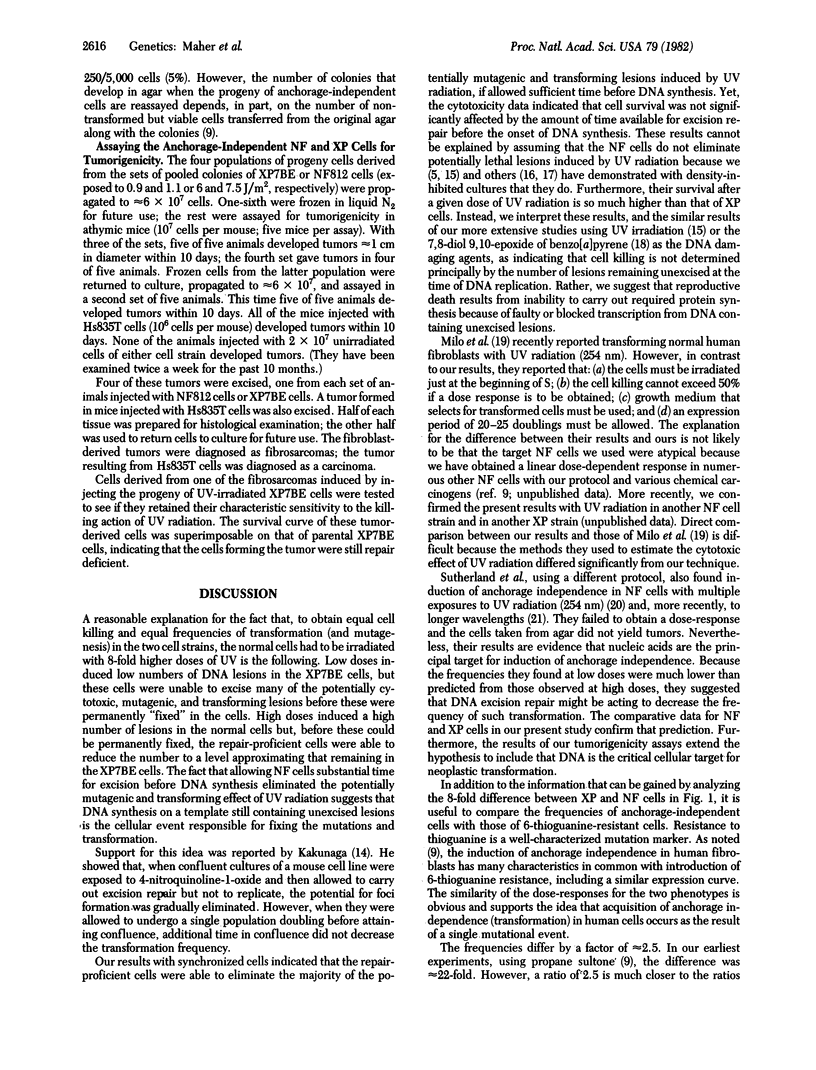
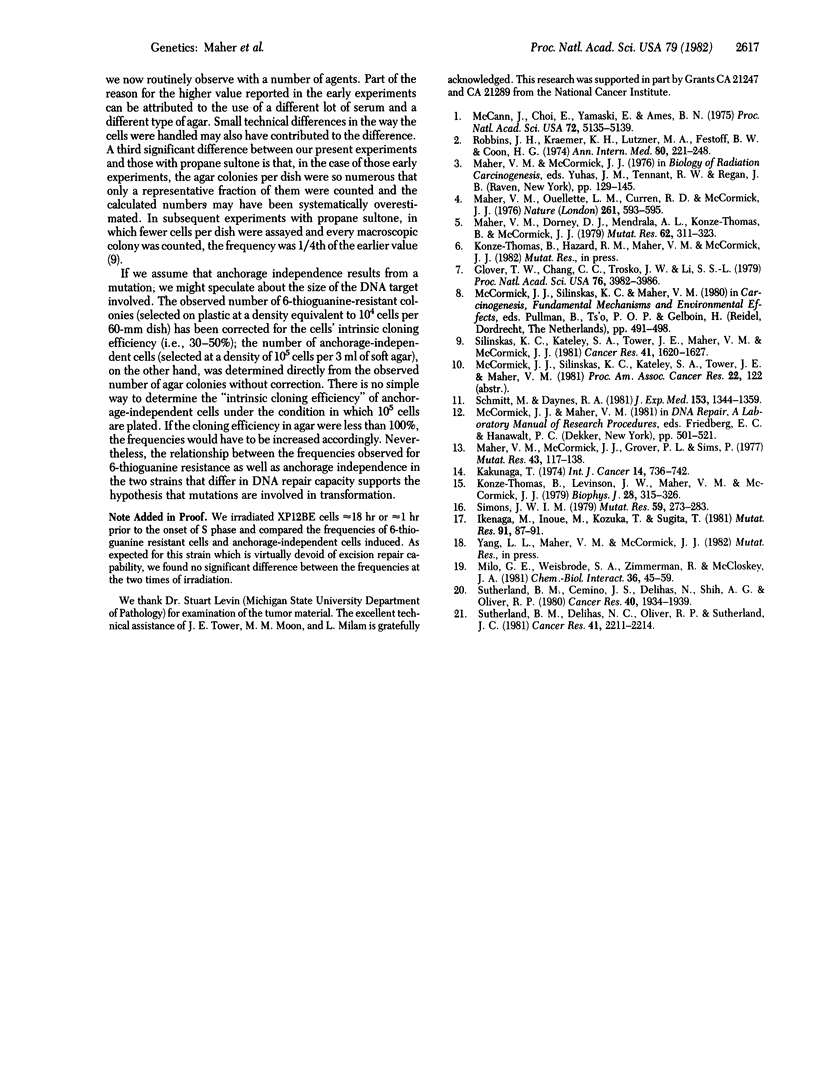
Selected References
These references are in PubMed. This may not be the complete list of references from this article.
- Glover T. W., Chang C. C., Trosko J. E., Li S. S. Ultraviolet light induction of diphtheria toxin-resistant mutants of normal and xeroderma pigmentosum human fibroblasts. Proc Natl Acad Sci U S A. 1979 Aug;76(8):3982–3986. doi: 10.1073/pnas.76.8.3982. [DOI] [PMC free article] [PubMed] [Google Scholar]
- Ikenaga M., Inoue M., Kozuka T., Sugita T. The recovery of colony-forming ability and the rate of semi-conservative DNA synthesis in ultraviolet-irradiated Cockayne and normal human cells. Mutat Res. 1981 Jan;91(1):87–91. doi: 10.1016/0165-7992(81)90077-4. [DOI] [PubMed] [Google Scholar]
- Kakunaga T. Requirement for cell replication in the fixation and expression of the transformed state in mouse cells treated with 4-nitroquinoline-1-oxide. Int J Cancer. 1974 Dec 15;14(6):736–742. doi: 10.1002/ijc.2910140607. [DOI] [PubMed] [Google Scholar]
- Konze-Thomas B., Levinson J. W., Maher V. M., McCormick J. J. Correlation among the rates of dimer excision, DNA repair replication, and recovery of human cells from potentially lethal damage induced by ultraviolet radiation. Biophys J. 1979 Nov;28(2):315–325. doi: 10.1016/S0006-3495(79)85179-6. [DOI] [PMC free article] [PubMed] [Google Scholar]
- Maher V. M., Dorney D. J., Mendrala A. L., Konze-Thomas B., McCormick J. J. DNA excision-repair processes in human cells can eliminate the cytotoxic and mutagenic consequences of ultraviolet irradiation. Mutat Res. 1979 Sep;62(2):311–323. doi: 10.1016/0027-5107(79)90087-3. [DOI] [PubMed] [Google Scholar]
- Maher V. M., McCormick J. J., Grover P. L., Sims P. Effect of DNA repair on the cytotoxicity and mutagenicity of polycyclic hydrocarbon derivatives in normal and xeroderma pigmentosum human fibroblasts. Mutat Res. 1977 Apr;43(1):117–138. doi: 10.1016/0027-5107(77)90137-3. [DOI] [PubMed] [Google Scholar]
- Maher V. M., Ouellette L. M., Curren R. D., McCormick J. J. Frequency of ultraviolet light-induced mutations is higher in xeroderma pigmentosum variant cells than in normal human cells. Nature. 1976 Jun 17;261(5561):593–595. doi: 10.1038/261593a0. [DOI] [PubMed] [Google Scholar]
- McCann J., Choi E., Yamasaki E., Ames B. N. Detection of carcinogens as mutagens in the Salmonella/microsome test: assay of 300 chemicals. Proc Natl Acad Sci U S A. 1975 Dec;72(12):5135–5139. doi: 10.1073/pnas.72.12.5135. [DOI] [PMC free article] [PubMed] [Google Scholar]
- Milo G. E., Weisbrode S. A., Zimmerman R., McCloskey J. A. Ultraviolet radiation-induced neoplastic transformation of normal human cells, in vitro. Chem Biol Interact. 1981 Jul;36(1):45–59. doi: 10.1016/0009-2797(81)90028-4. [DOI] [PubMed] [Google Scholar]
- Robbins J. H., Kraemer K. H., Lutzner M. A., Festoff B. W., Coon H. G. Xeroderma pigmentosum. An inherited diseases with sun sensitivity, multiple cutaneous neoplasms, and abnormal DNA repair. Ann Intern Med. 1974 Feb;80(2):221–248. doi: 10.7326/0003-4819-80-2-221. [DOI] [PubMed] [Google Scholar]
- Schmitt M., Daynes R. A. Heterogeneity of tumorigenicity phenotype in murine tumors. I. Characterization of regressor and progressor clones isolated from a nonmutagenized ultraviolet regressor tumor. J Exp Med. 1981 May 1;153(5):1344–1359. doi: 10.1084/jem.153.5.1344. [DOI] [PMC free article] [PubMed] [Google Scholar]
- Silinskas K. C., Kateley S. A., Tower J. E., Maher V. M., McCormick J. J. Induction of anchorage-independent growth in human fibroblasts by propane sultone. Cancer Res. 1981 May;41(5):1620–1627. [PubMed] [Google Scholar]
- Sutherland B. M., Cimino J. S., Delihas N., Shih A. G., Oliver R. P. Ultraviolet light-induced transformation of human cells to anchorage-independent growth. Cancer Res. 1980 Jun;40(6):1934–1939. [PubMed] [Google Scholar]
- Sutherland B. M., Delihas N. C., Oliver R. P., Sutherland J. C. Action spectra for ultraviolet light-induced transformation of human cells to anchorage-independent growth. Cancer Res. 1981 Jun;41(6):2211–2214. [PubMed] [Google Scholar]


